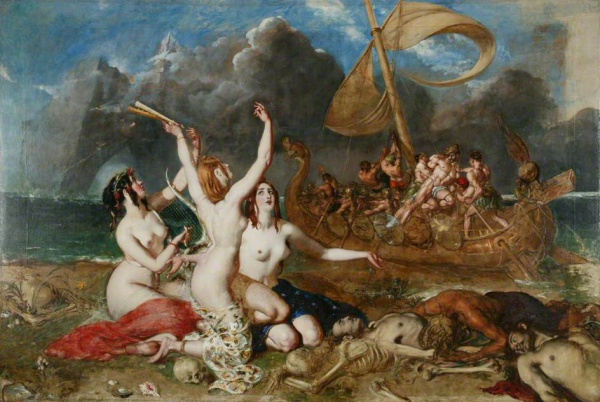Facts About The Sirens and Ulysses
"The Sirens and Ulysses" is a stunning oil painting by William Etty, vividly bringing to life a dramatic scene from Homer's "Odyssey." In this episode, Ulysses cleverly evades the deadly allure of the Sirens' song by having his crew bind him to the ship's mast while plugging their ears with wax.
Departing from the traditional depiction of Sirens as part-human, part-animal hybrids, Etty chose to represent them as beautiful, nude women on an island strewn with decaying corpses. This daring artistic decision sparked considerable controversy when the painting was first exhibited in 1837. Critics were divided, with some admiring the artwork and others repulsed by its morbid content and sheer scale. Although it did not sell immediately, Daniel Grant eventually purchased it and later donated it to the Royal Manchester Institution.
William Etty, known for his fascination with the human form and influenced by masters such as Titian and Rubens, tackled the theme of Ulysses and the Sirens at the suggestion of Thomas Myers. Myers believed there was a market for large, dramatic paintings. Etty's rendition aimed to convey a moral message about the significance of resisting sensual temptations. However, his approach was not universally appreciated, and the painting received criticism for both its subject matter and artistic execution.
In the composition, Ulysses is depicted bound to the mast while the Sirens sing from their grim and desolate island. Etty's decision to use real corpses as models for the background added to the painting's notorious reputation. Unfortunately, the painting's large size and experimental techniques caused it to begin deteriorating shortly after its completion.
In 2003, restoration efforts commenced, funded by the Esmée Fairbairn Foundation and AXA Art Insurance. After years of meticulous work, the painting was finally restored and unveiled at the Manchester Art Gallery in 2010, following decades in storage.
Etty always regarded "The Sirens and Ulysses" as his masterpiece, even though it did not significantly influence subsequent artists. The restoration process was exacting, involving the removal of a damaged layer and the addition of new canvas. Today, this impressive work is displayed in Gallery Three of the Manchester Art Gallery, where visitors can appreciate Etty's distinctive vision and artistic prowess.

 Ireland
Ireland